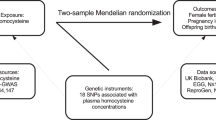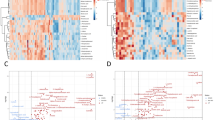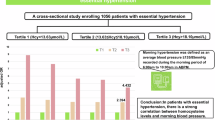Abstract
Homocysteine is associated with endothelial dysfunction and cardiovascular disease, and elevated concentrations of homocysteine have been found in preeclampsia. The purpose of this study was to investigate maternal and fetal concentrations of total homocysteine and related metabolites (including cysteine, choline, and betaine), and possible associations with infant birth weight. Women with preeclampsia (n = 47) and controls (n = 51), who underwent cesarean section, were included. Maternal plasma, umbilical vein, and artery plasma were analyzed. Median concentrations of homocysteine, cysteine, choline, and betaine were significantly higher in women with preeclampsia than controls, both in maternal and fetal plasma. There were no differences in folate and vitamin B12 concentrations between the groups, neither for maternal nor fetal samples. Maternal homocysteine concentration was a negative predictor for birth weight only in the preeclampsia group. Elevated homocysteine and cysteine concentration in maternal circulation in preeclampsia is reflected in the fetal circulation. The clinical significance of elevated homocysteine and cysteine concentrations in maternal and fetal compartments in preeclampsia remain to be explored, both regarding fetal growth and development of disease later in life.
Similar content being viewed by others
Log in or create a free account to read this content
Gain free access to this article, as well as selected content from this journal and more on nature.com
or
Abbreviations
- BHMT:
-
betaine-homocysteine methyltransferase
- DMG:
-
dimethylglycine
- HPLC:
-
high-performance liquid chromatography
- MTHFR:
-
methylenetetrahydrofolate reductase
- SGA:
-
small for gestational age
- tCys:
-
total cysteine
- tHcy:
-
total homocysteine
References
Roberts JM, Redman CW 1993 Pre-eclampsia: more than pregnancy-induced hypertension. Lancet 341: 1447–1451
Sibai B, Dekker G, Kupferminc M 2005 Pre-eclampsia. Lancet 365: 785–799
Wilson KM, Lentz SR 2005 Mechanisms of the atherogenic effects of elevated homocysteine in experimental models. Semin Vasc Med 5: 163–171
Homocysteine Studies Collaboration 2002 Homocysteine and risk of ischemic heart disease and stroke: a meta-analysis. JAMA 288: 2015–2022
El-Khairy L, Ueland PM, Refsum H, Graham IM, Vollset SE 2001 Plasma total cysteine as a risk factor for vascular disease: the European Concerted Action Project. Circulation 103: 2544–2549
Murphy MM, Scott JM, Arija V, Molloy AM, Fernandez-Ballart JD 2004 Maternal homocysteine before conception and throughout pregnancy predicts fetal homocysteine and birth weight. Clin Chem 50: 1406–1412
Malinow MR, Rajkovic A, Duell PB, Hess DL, Upson BM 1998 The relationship between maternal and neonatal umbilical cord plasma homocyst(e) ine suggests a potential role for maternal homocyst(e)ine in fetal metabolism. Am J Obstet Gynecol 178: 228–233
Powers RW, Evans RW, Majors AK, Ojimba JI, Ness RB, Crombleholme WR, Roberts JM 1998 Plasma homocysteine concentration is increased in preeclampsia and is associated with evidence of endothelial activation. Am J Obstet Gynecol 179: 1605–1611
Raijmakers MT, Zusterzeel PL, Steegers EA, Hectors MP, Demacker PN, Peters WH 2000 Plasma thiol status in preeclampsia. Obstet Gynecol 95: 180–184
El-Khairy L, Vollset SE, Refsum H, Ueland PM 2003 Plasma total cysteine, pregnancy complications, and adverse pregnancy outcomes: the Hordaland Homocysteine Study. Am J Clin Nutr 77: 467–472
Sorensen TK, Malinow MR, Williams MA, King IB, Luthy DA 1999 Elevated second-trimester serum homocyst(e)ine levels and subsequent risk of preeclampsia. Gynecol Obstet Invest 48: 98–103
Cotter AM, Molloy AM, Scott JM, Daly SF 2001 Elevated plasma homocysteine in early pregnancy: a risk factor for the development of severe preeclampsia. Am J Obstet Gynecol 185: 781–785
Mignini LE, Latthe PM, Villar J, Kilby MD, Carroli G, Khan KS 2005 Mapping the theories of preeclampsia: the role of homocysteine. Obstet Gynecol 105: 411–425
Craig SA 2004 Betaine in human nutrition. Am J Clin Nutr 80: 539–549
Zeisel SH, Niculescu MD 2006 Perinatal choline influences brain structure and function. Nutr Rev 64: 197–203
Molloy AM, Mills JL, Cox C, Daly SF, Conley M, Brody LC, Kirke PN, Scott JM, Ueland PM 2005 Choline and homocysteine interrelations in umbilical cord and maternal plasma at delivery. Am J Clin Nutr 82: 836–842
Velzing-Aarts FV, Holm PI, Fokkema MR, van der Dijs FP, Ueland PM, Muskiet FA 2005 Plasma choline and betaine and their relation to plasma homocysteine in normal pregnancy. Am J Clin Nutr 81: 1383–1389
Braekke K, Holthe MR, Kittelsen N, Fagerhol MK, Staff A 2005 Calprotectin, a marker of inflammation, is elevated in the maternal but not in the fetal circulation in preeclampsia. Am J Obstet Gynecol 193: 227–233
Johnsen SL, Rasmussen S, Wilsgaard T, Sollien R, Kiserud T 2006 Longitudinal reference ranges for estimated fetal weight. Acta Obstet Gynecol Scand 85: 286–297
Bohn SK, Smeland S, Sakhi AK, Thoresen M, Russnes KM, Tausjo J, Svilaas A, Svilaas T, Blomhoff R 2005 Post-radiotherapy plasma total glutathione is associated to outcome in patients with head and neck squamous cell carcinoma. Cancer Lett 238: 240–247
Kelleher BP, Broin SD 1991 Microbiological assay for vitamin B12 performed in 96-well microtitre plates. J Clin Pathol 44: 592–595
O'Broin S, Kelleher B 1992 Microbiological assay on microtitre plates of folate in serum and red cells. J Clin Pathol 45: 344–347
Holm PI, Ueland PM, Kvalheim G, Lien EA 2003 Determination of choline, betaine, and dimethylglycine in plasma by a high-throughput method based on normal-phase chromatography-tandem mass spectrometry. Clin Chem 49: 286–294
ACOG Committee on Practice Bulletins—Obstetrics 2002 ACOG practice bulletin. Diagnosis and management of preeclampsia and eclampsia. Number 33, January 2002. Obstet Gynecol 99: 159–167
Holmes VA, Wallace JM, Alexander HD, Gilmore WS, Bradbury I, Ward M, Scott JM, McFaul P, McNulty H 2005 Homocysteine is lower in the third trimester of pregnancy in women with enhanced folate status from continued folic acid supplementation. Clin Chem 51: 629–634
Powers RW, Majors AK, Kerchner LJ, Conrad KP 2004 Renal handling of homocysteine during normal pregnancy and preeclampsia. J Soc Gynecol Investig 11: 45–50
Ueland PM, Holm PI, Hustad S 2005 Betaine: a key modulator of one-carbon metabolism and homocysteine status. Clin Chem Lab Med 43: 1069–1075
Braekke K, Staff AC 2003 Periconceptional use of folic acid supplements in Oslo. Acta Obstet Gynecol Scand 82: 620–627
Molloy AM, Mills JL, McPartlin J, Kirke PN, Scott JM, Daly S 2002 Maternal and fetal plasma homocysteine concentrations at birth: the influence of folate, vitamin B12, and the. Am J Obstet Gynecol 186: 499–503
Cetin I, Ronzoni S, Marconi AM, Perugino G, Corbetta C, Battaglia FC, Pardi G 1996 Maternal concentrations and fetal-maternal concentration differences of plasma amino acids in normal and intrauterine growth-restricted pregnancies. Am J Obstet Gynecol 174: 1575–1583
Regnault TR, Friedman JE, Wilkening RB, Anthony RV, Hay WW Jr 2005 Fetoplacental transport and utilization of amino acids in IUGR-a review. Placenta 26: AA S52–S62.
Evans RW, Powers RW, Ness RB, Cropcho LJ, Daftary AR, Harger GF, Vergona R, Finegold DN 2003 Maternal and fetal amino acid concentrations and fetal outcomes during pre-eclampsia. Reproduction 125: 785–790
Wang J, Trudinger BJ, Duarte N, Wilcken DE, Wang XL 2000 Elevated circulating homocyst (e) ine levels in placental vascular disease and associated pre-eclampsia. BJOG 107: 935–938
Ophir E, Dourleshter G, Hirsh Y, Fait V, German L, Bornstein J 2006 Newborns of pre-eclamptic women: a biochemical difference present in utero. Acta Obstet Gynecol Scand 85: 1172–1178
Friedman SA, Schiff E, Emeis JJ, Dekker GA, Kao L, Sibai BM 1997 Fetal plasma levels of cellular fibronectin as a measure of fetal endothelial involvement in preeclampsia. Obstet Gynecol 89: 46–48
Krauss T, Azab H, Dietrich M, Augustin HG 1998 Fetal plasma levels of circulating endothelial cell adhesion molecules in normal and preeclamptic pregnancies. Eur J Obstet Gynecol Reprod Biol 78: 41–45
Braekke K, Harsem NK, Staff AC 2006 Oxidative stress and antioxidant status in fetal circulation in preeclampsia. Pediatr Res 60: 560–564
Harsem NK, Braekke K, Staff AC 2006 Augmented oxidative stress as well as antioxidant capacity in maternal circulation in preeclampsia. Eur J Obstet Gynecol Reprod Biol 128: 209–215
Ray JG, Mamdani MM 2002 Association between folic acid food fortification and hypertension or preeclampsia in pregnancy. Arch Intern Med 162: 1776–1777
Bodnar LM, Tang G, Ness RB, Harger G, Roberts JM 2006 Periconceptional multivitamin use reduces the risk of preeclampsia. Am J Epidemiol 164: 470–477
Hernandez-Diaz S, Werler MM, Louik C, Mitchell AA 2002 Risk of gestational hypertension in relation to folic acid supplementation during pregnancy. Am J Epidemiol 156: 806–812
Acknowledgements
Professor Leif Sandvik at Ulleval University Hospital is gratefully acknowledged for help with the statistical analyses.
Author information
Authors and Affiliations
Corresponding author
Rights and permissions
About this article
Cite this article
Braekke, K., Ueland, P., Harsem, N. et al. Homocysteine, Cysteine, and Related Metabolites in Maternal and Fetal Plasma in Preeclampsia. Pediatr Res 62, 319–324 (2007). https://doi.org/10.1203/PDR.0b013e318123fba2
Received:
Accepted:
Issue date:
DOI: https://doi.org/10.1203/PDR.0b013e318123fba2
This article is cited by
-
Applications of metabolomics in the study and management of preeclampsia: a review of the literature
Metabolomics (2017)
-
Umbilical choline and related methylamines betaine and dimethylglycine in relation to birth weight
Pediatric Research (2013)
-
Choline and betaine in health and disease
Journal of Inherited Metabolic Disease (2011)



